SpringBoot-集成Swagger
1 - Swagger简介
1、导语
2、前后端分离
-
前端 -> 前端控制层、视图层
-
后端 -> 后端控制层、服务层、数据访问层
-
前后端通过API进行交互
-
前后端相对独立且松耦合
3、产生的问题
-
前后端集成,前端或者后端无法做到“及时协商,尽早解决”,最终导致问题集中爆发
4、解决方案
-
首先定义schema [ 计划的提纲 ],并实时跟踪最新的API,降低集成风险
5、Swagger是什么?
1、是一款让你更好的书写API文档的规范且完整框架。
2、提供描述、生产、消费和可视化RESTful Web Service。Restful Api 文档在线自动生成器 => API 文档 与API 定义同步更新
3、是由庞大工具集合支撑的形式化规范。这个集合涵盖了从终端用户接口、底层代码库到商业API管理的方方面面。
4、直接运行,在线测试API
5、支持多种语言(如:Java、PHP)
2 - SpringBoot集成Swagger
使用Swagger
要求:jdk 1.8 + 否则swagger2无法运行
1、新建一个SpringBoot-Web项目
2、在pom文件中导入两个官方提供的maven依赖
<!-- https://mvnrepository.com/artifact/io.springfox/springfox-swagger2 --> <dependency> <groupId>io.springfox</groupId> <artifactId>springfox-swagger2</artifactId> <version>2.9.2</version> </dependency> <!-- https://mvnrepository.com/artifact/io.springfox/springfox-swagger-ui --> <dependency> <groupId>io.springfox</groupId> <artifactId>springfox-swagger-ui</artifactId> <version>2.9.2</version> </dependency>
3、编写一个HelloController,确保项目能够正常运行
@RestController public class HelloController { @RequestMapping(path = "/hello",method = RequestMethod.GET) public String hello(){ return "hello world"; } }
4、要使用Swagger,我们需要编写一个配置类 SwaggerConfig 来配置 Swagger
package com.howie.config; import org.springframework.context.annotation.Configuration; import springfox.documentation.swagger2.annotations.EnableSwagger2; @Configuration // 表明 spring boot的配置类 @EnableSwagger2 // 开启Swagger2 public class SwaggerConfig { }
5、测试访问:http://localhost:8080/swagger-ui.html,此时我们可以看到 Swagge r的 ui 页面
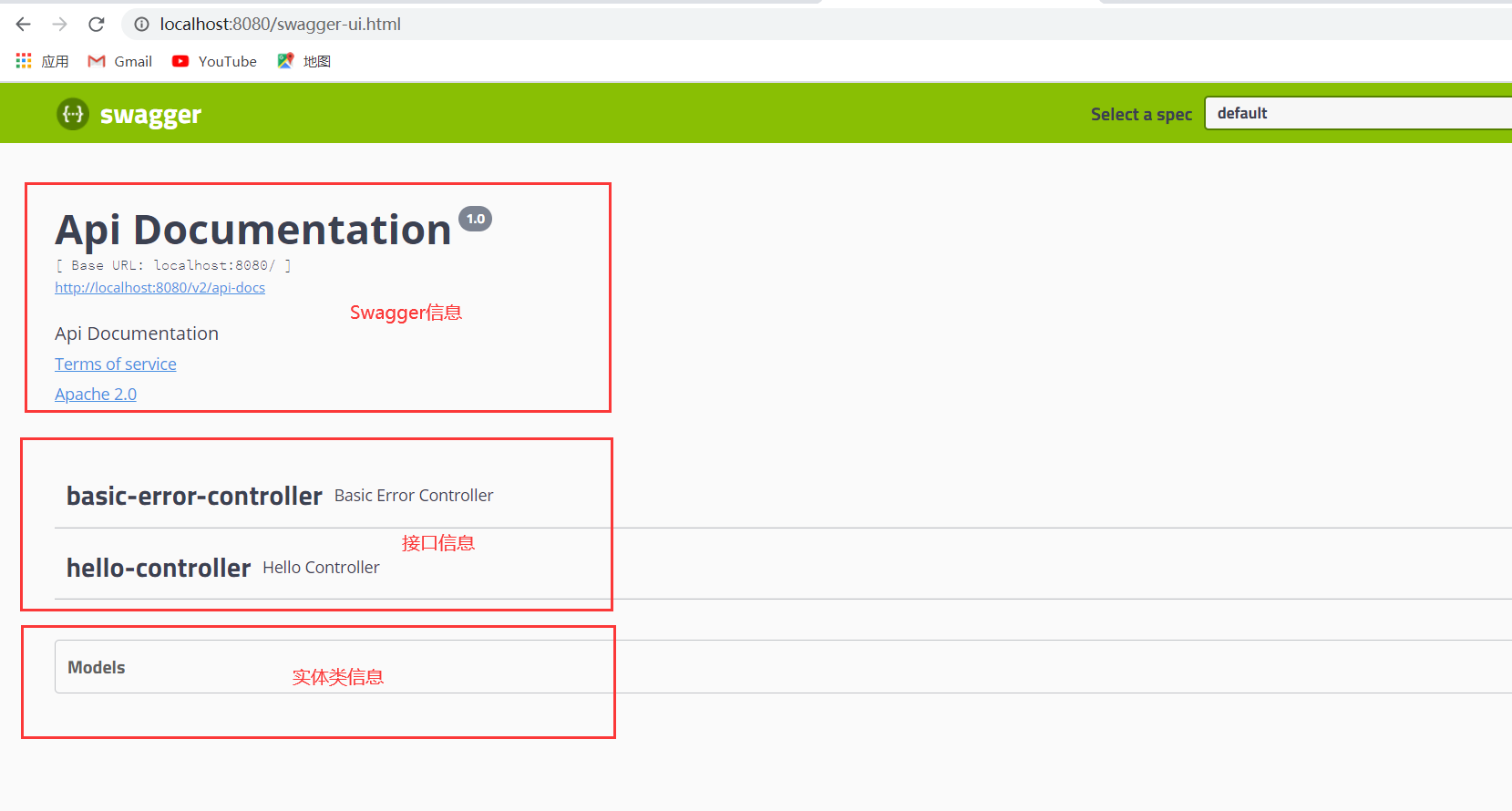
3 - 配置Swagger
1、Swagger实例Bean是Docket,所以通过配置Docket实例来配置Swaggger。
// 配置Swagger的Bean实例 @Bean public Docket docket(){ return new Docket(DocumentationType.SWAGGER_2); }
2、可以通过apiInfo()属性配置文档信息
//配置文档信息 private ApiInfo apiInfo() { Contact contact = new Contact("联系人名字", "http://xxx.xxx.com/联系人访问链接", "联系人邮箱"); return new ApiInfo( "Swagger学习", // 标题 "学习演示如何配置Swagger", // 描述 "v1.0", // 版本 "http://terms.service.url/组织链接", // 组织链接 contact, // 联系人信息 "Apach 2.0 许可", // 许可 "许可链接", // 许可连接 new ArrayList<>()// 扩展 ); }
代码示例
// 配置Swagger的apiInfo信息 private ApiInfo apiInfo(){ // 作者信息 Contact contact = new Contact("howie", "http://localhost:8080/", "3299447929@qq.com"); return new ApiInfo( "Howie的Swagger API文档", "学习没有捷径!", "1.0", "http://localhost:8080", contact, "Apache 2.0", "http://www.apache.org/licenses/LICENSE-2.0", new ArrayList<VendorExtension>()); }
3、Docket 实例关联上 apiInfo()
// 配置Swagger的Bean实例 @Bean public Docket docket(){ return new Docket(DocumentationType.SWAGGER_2).apiInfo(apiInfo()); }
4、重启项目,访问测试 http://localhost:8080/swagger-ui.html 看下效果
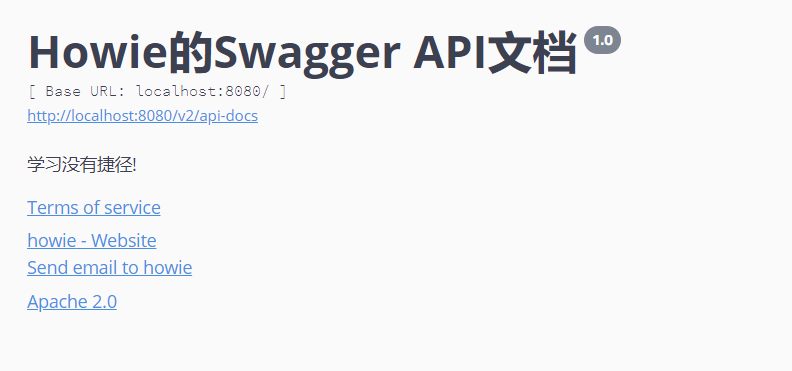
4 - 配置扫描接口
1、构建Docket时通过select()方法配置怎么扫描接口。
@Bean public Docket docket() { return new Docket(DocumentationType.SWAGGER_2) .apiInfo(apiInfo()) .select()// 通过.select()方法,去配置扫描接口,RequestHandlerSelectors配置如何扫描接口 .apis(RequestHandlerSelectors.basePackage("com.kuang.swagger.controller")) .build(); }
2、重启项目测试,由于我们配置根据包的路径扫描接口,所以我们只能看到一个类

3、除了通过包路径配置扫描接口外,还可以通过配置其他方式扫描接口,这里注释一下所有的配置方式
any() // 扫描所有,项目中的所有接口都会被扫描到 none() // 不扫描接口 // 通过方法上的注解扫描,如withMethodAnnotation(GetMapping.class)只扫描get请求 withMethodAnnotation(final Class<? extends Annotation> annotation)
// 通过类上的注解扫描,如.withClassAnnotation(Controller.class)只扫描有controller注解的类中的接口 withClassAnnotation(final Class<? extends Annotation> annotation) basePackage(final String basePackage) // 根据包路径扫描接口
4、除此之外,我们还可以配置接口扫描过滤:
@Bean public Docket docket(){ return new Docket(DocumentationType.SWAGGER_2).apiInfo(apiInfo()).select() // RequestHandlerSelector 配置要扫描的接口方式 // basePackage:指定要扫描的包 // any() 扫描全部 // none() 不扫描 // withClassAnnotation() 扫描类上的注解,参数是一个注解的反射对象 // withMethodAnnotation() 扫描方法上的注解 .apis(RequestHandlerSelectors.basePackage("com.howie.controller")) // paths() 要过滤什么路径 .paths(PathSelectors.ant("/howie/**")) .build(); }
5、这里的可选值还有
any() // 任何请求都扫描 none() // 任何请求都不扫描 regex(final String pathRegex) // 通过正则表达式控制 ant(final String antPattern) // 通过ant()控制
5 - 配置Swagger开关
1、通过enable()方法配置是否启用swagger,如果是false,swagger将不能在浏览器中访问了
// 配置Swagger的Bean实例 @Bean public Docket docket(){ return new Docket(DocumentationType.SWAGGER_2).apiInfo(apiInfo()) .enable(false) // 配置swagger开关,此时Swagger不能在浏览器中访问 .select() // RequestHandlerSelector 配置要扫描的接口方式 // basePackage:指定要扫描的包 // any() 扫描全部 // none() 不扫描 // withClassAnnotation() 扫描类上的注解,参数是一个注解的反射对象 // withMethodAnnotation() 扫描方法上的注解 .apis(RequestHandlerSelectors.basePackage("com.howie.controller")) // paths() 要过滤什么路径 // .paths(PathSelectors.ant("/howie/**")) .build(); }
2、如何动态配置当项目处于test、dev(生产) 环境时显示swagger,处于 prod(发布) 时不显示?
- 判断是不是生产环境
- 注入enable()
@Bean public Docket docket(Environment environment) { // 设置要显示swagger的环境 Profiles of = Profiles.of("dev", "test"); // 判断当前是否处于该环境 // 通过 enable() 接收此参数判断是否要显示 boolean isProd = environment.acceptsProfiles(of); return new Docket(DocumentationType.SWAGGER_2) .apiInfo(apiInfo()) .enable(isProd) //配置是否启用Swagger,如果是false,在浏览器将无法访问 .select()// 通过.select()方法,去配置扫描接口,RequestHandlerSelectors配置如何扫描接口 .apis(RequestHandlerSelectors.basePackage("com.kuang.swagger.controller")) // 配置如何通过path过滤,即这里只扫描请求以/kuang开头的接口 .paths(PathSelectors.ant("/kuang/**")) .build(); }
3、可以在项目中增加一个dev的配置文件查看效果!

6 - 配置API分组
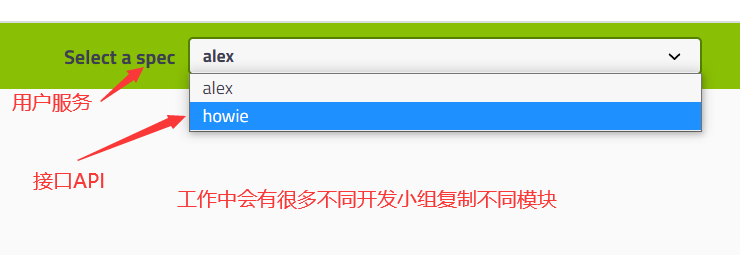
1、如果没有配置分组,默认是default。通过groupName()方法即可配置分组
@Bean public Docket docket(Environment environment) { return new Docket(DocumentationType.SWAGGER_2).apiInfo(apiInfo()) .groupName("hello") // 配置分组 // 省略配置.... }
2、重启项目查看分组
3、如何配置多个分组?配置多个分组只需要配置多个docket即可
@Bean public Docket docket1(){ return new Docket(DocumentationType.SWAGGER_2).groupName("group1"); } @Bean public Docket docket2(){ return new Docket(DocumentationType.SWAGGER_2).groupName("group2"); } @Bean public Docket docket3(){ return new Docket(DocumentationType.SWAGGER_2).groupName("group3"); }
4、重启项目查看即可
7 - 实体配置
1、新建一个实体类
@ApiModel(value = "用户实体类") public class User { @ApiModelProperty(value = "用户名") public String username; @ApiModelProperty(value = "密码") public String password; }
2、只要这个实体在请求接口的返回值上(即使是泛型),都能映射到实体项中
// 在接口中,只要返回值中存在实体类,就会被扫描到Swagger中 @RequestMapping(path = "/user") public User user(){ return new User(); }
3、重启查看测试
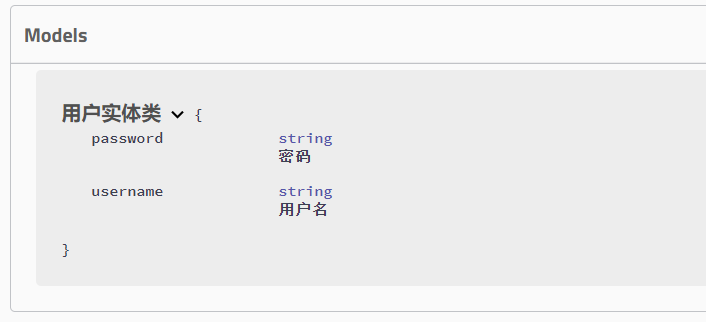
注:并不是因为@ApiModel这个注解让实体显示在这里了,而是只要出现在接口方法的返回值上的实体都会显示在这里,而@ApiModel和@ApiModelProperty这两个注解只是为实体添加注释的。
@ApiModel为类添加注释
@ApiModelProperty为类属性添加注释
8 - Swagger常用注解
Swagger 的所有注解定义在 io.swagger.annotations 包下
下面列一些经常用到的,未列举出来的可以另行查阅说明
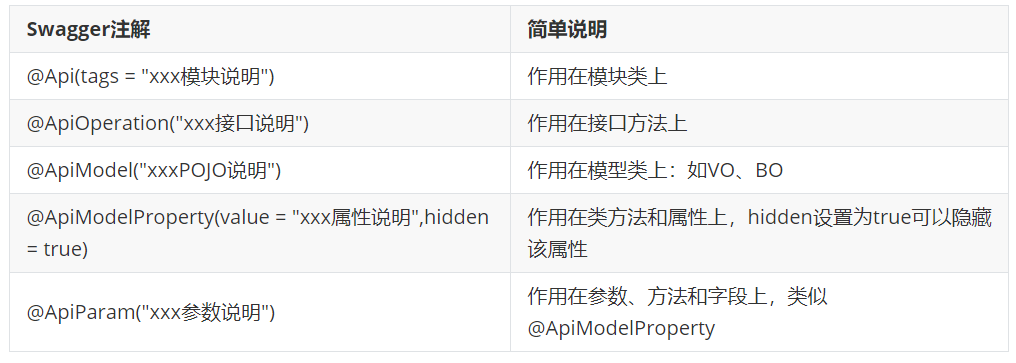
我们也可以给请求的接口配置一些注释
@ApiOperation("返回用户名的接口")
@PostMapping("/get_name")
@ResponseBody
public String kuang(@ApiParam("这个名字会被返回")String username){
return username;
}
这样的话,可以给一些比较难理解的属性或者接口,增加一些配置信息,让人更容易阅读!
相较于传统的Postman或Curl方式测试接口,使用swagger简直就是傻瓜式操作,不需要额外说明文档(写得好本身就是文档)而且更不容易出错,只需要录入数据然后点击Execute,
如果再配合自动化框架,可以说基本就不需要人为操作了。
Swagger是个优秀的工具,现在国内已经有很多的中小型互联网公司都在使用它,相较于传统的要先出Word接口文档再测试的方式,显然这样也更符合现在的快速迭代开发行情。
当然了,提醒下大家在正式环境要记得关闭Swagger,一来出于安全考虑二来也可以节省运行时内存。
总结:
1、我们可以通过Swagger 给一些比较难理解的属性或者接口,增加注释信息
2、接口文档实时更新
3、还可以在线测试一些接口


